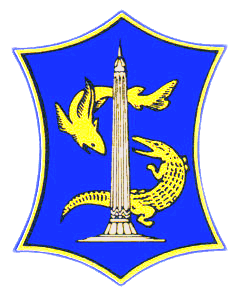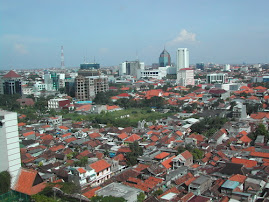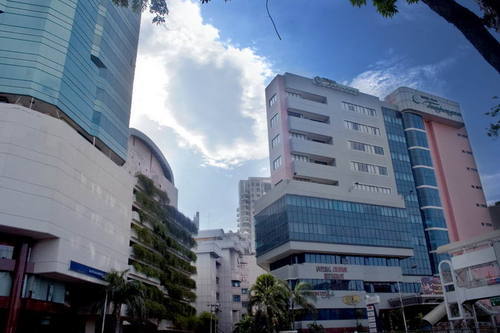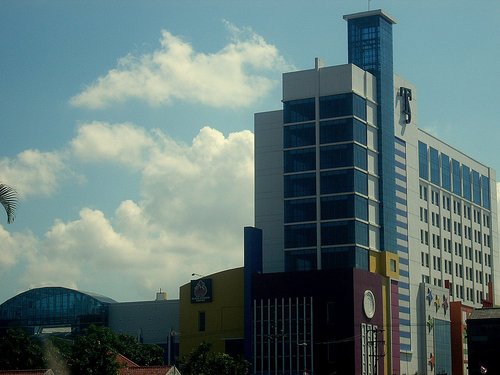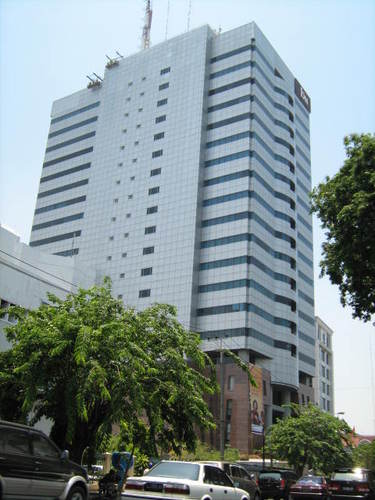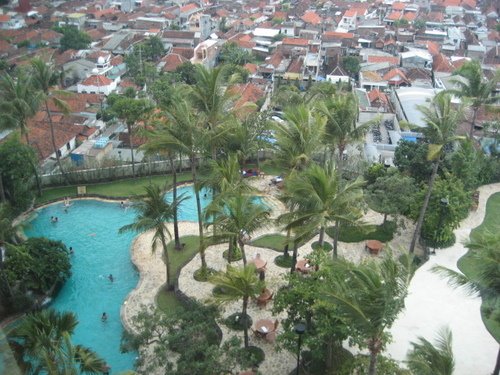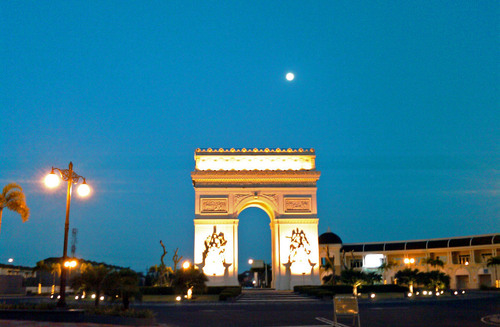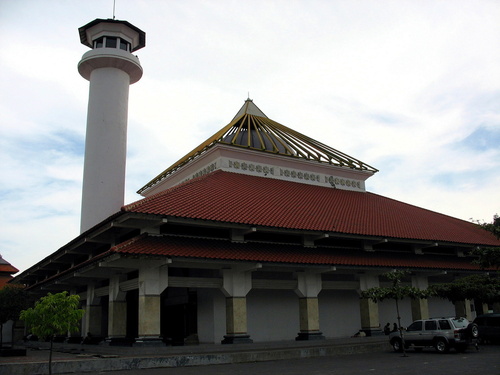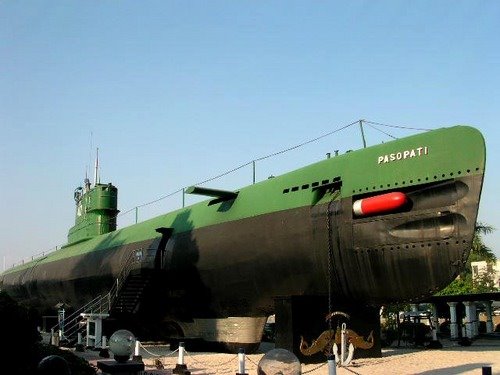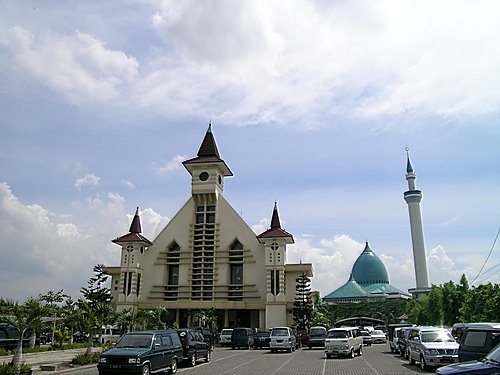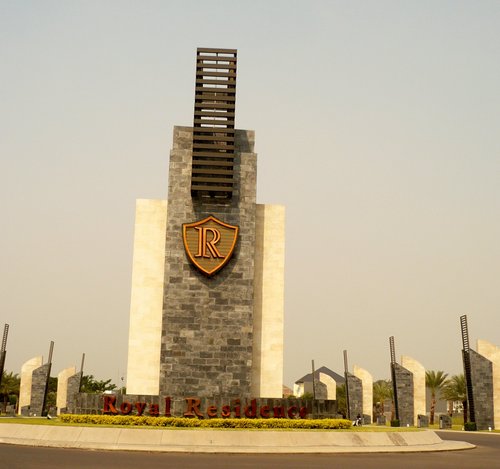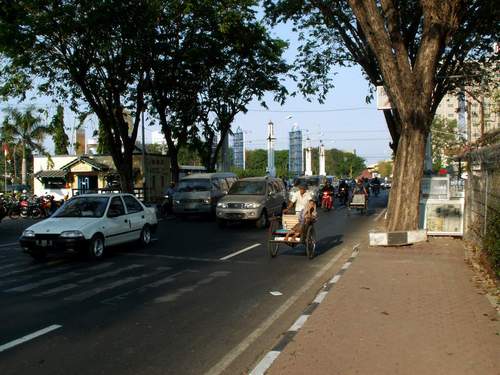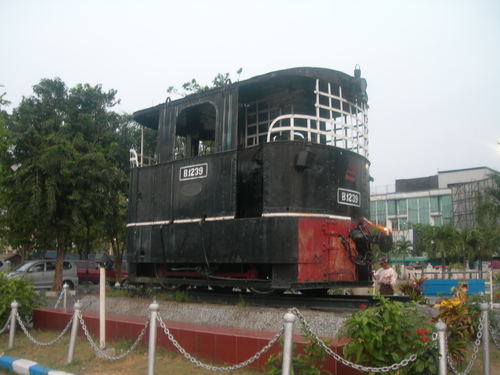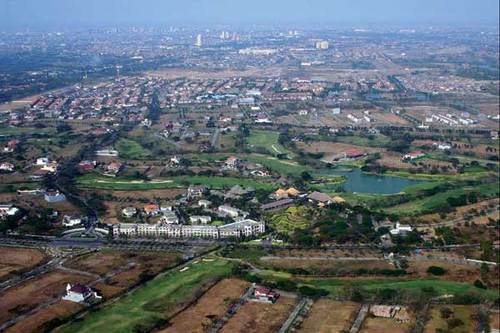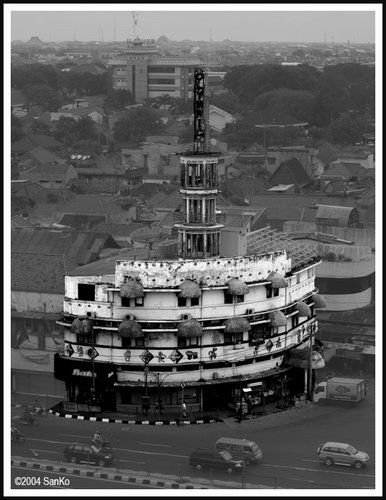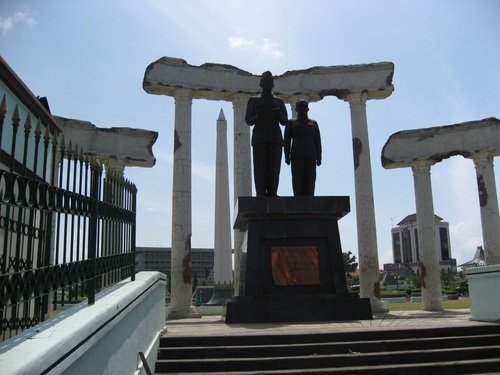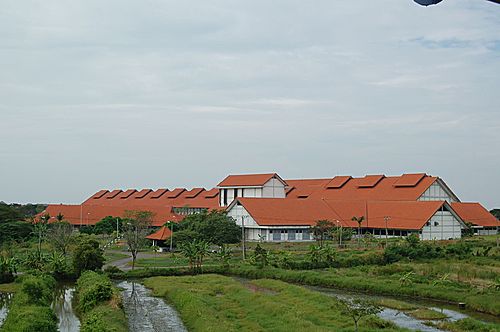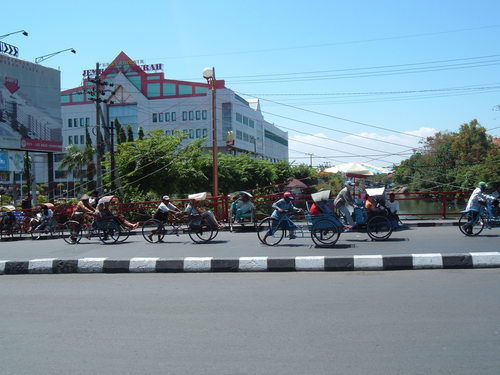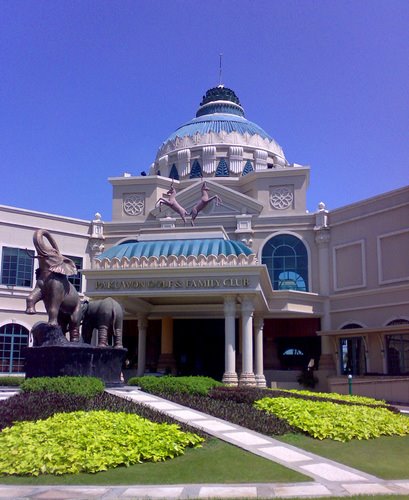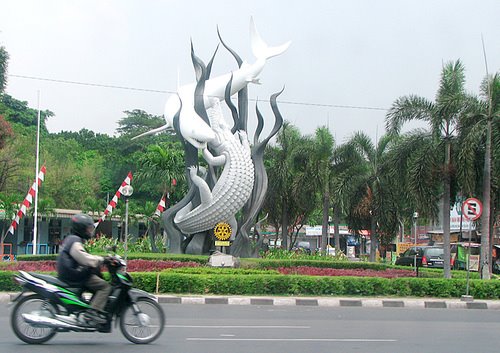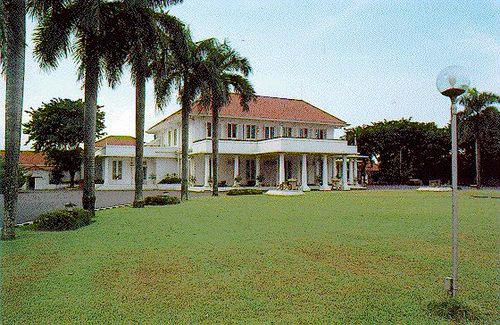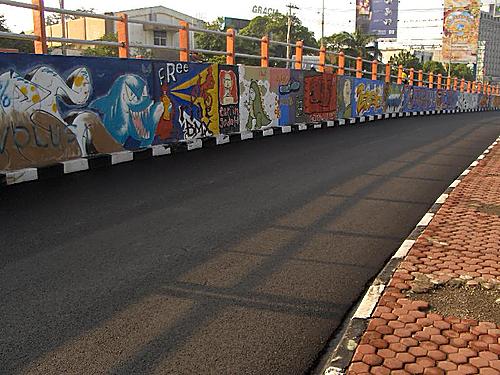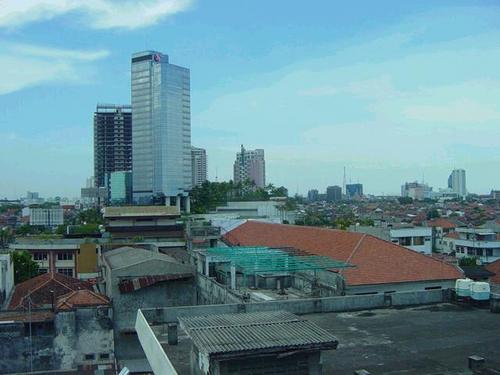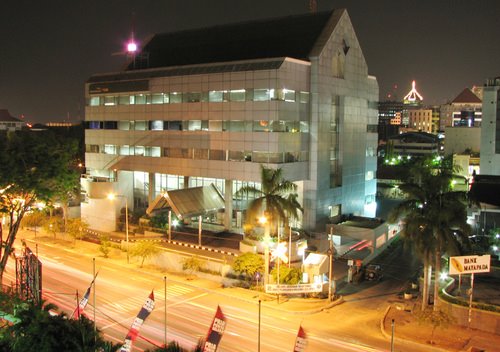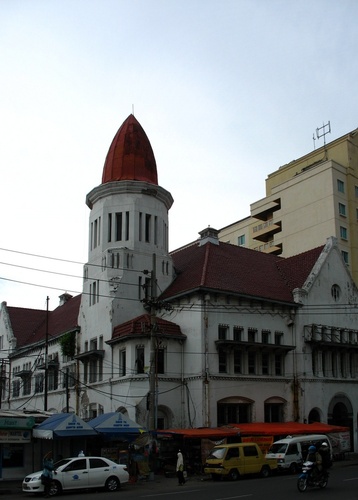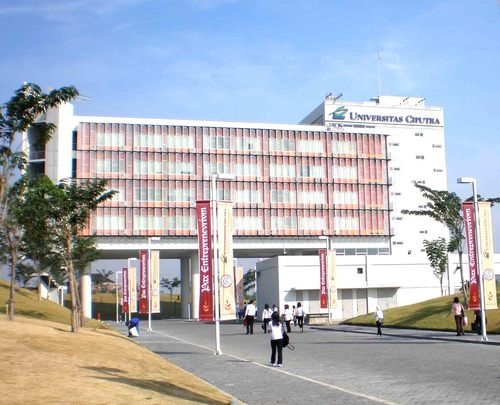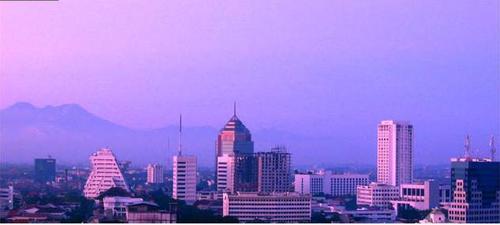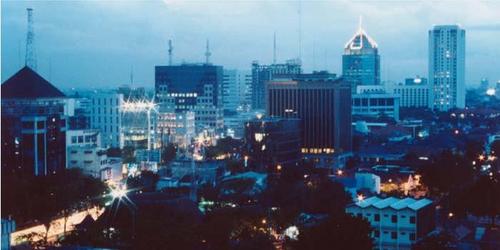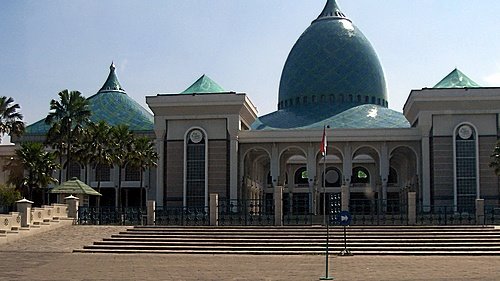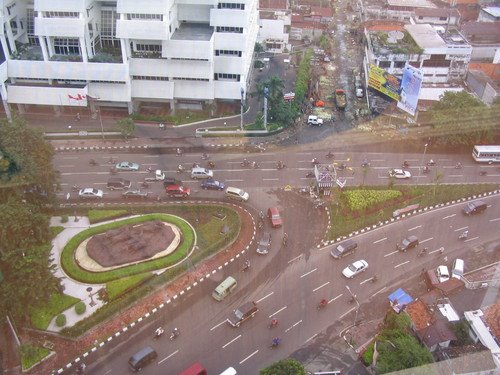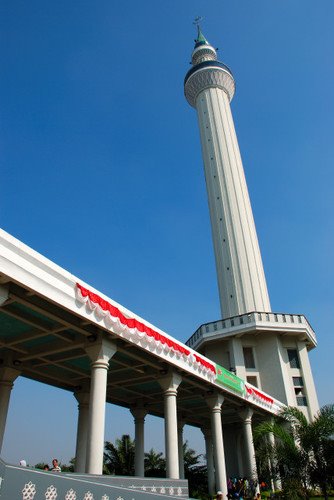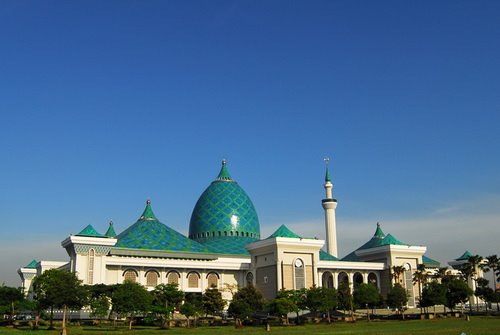Surabaya
From Wikipedia, the free encyclopedia
| Surabaya Soerabaja | |||
| Downtown Surabaya | |||
| |||
| Nickname(s): SBY | |||
| Motto: Surabaya bersih dan hijau (English: Surabaya green and clean) | |||
| Location of Surabaya in Indonesia | |||
| Coordinates: | |||
| Country | Indonesia | ||
|---|---|---|---|
| Province | East Java | ||
| Area | |||
| - Total | 274.06 km² (105.8 sq mi) | ||
| Elevation | 5 m (16 ft) | ||
| Population (2005) | |||
| - Total | approx. 3 million [1] | ||
| Time zone | WIB (UTC+7) | ||
| Website: surabaya.go.id | |||
Surabaya (formerly spelled as Soerabaja) is Indonesia's second-largest city, and the capital of the province of East Java. It is located on the northern shore of eastern Java at the mouth of the Mas River and at the side of the Madura Strait. It is known as the city of heroes, because of its role in the Indonesian War of Independence. In 2007, the population of the city was approximately 3 million.
Contents[hide] |
[edit] Etymology
Surabaya is commonly said to derive its name from the words sura or suro (shark) and baya or boyo (crocodile), two creatures which, in a local myth, fought each other in order to gain the title of "the strongest and most powerful animal" in the area according to a Jayabaya prophecy. This prophecy tells of a fight between a giant white shark and a giant white crocodile. Now the two animals are used as the city's logo, the two facing each other while circling the city's monument, the Heroes Monument. This folk etymology, though embraced enthusiastically by city leaders, is somewhat dubious. Alternate derivations proliferate: e.g. from the Javanese sura ing baya, meaning "bravely facing danger". Some people consider this Jayabaya prophecy as a great war between Surabaya native people and invaders in 1945, while another story is about two heroes that fought each other in order to be the king of the city. The two heroes were Sura and Baya.
[edit] History

The earliest record of Suyabaya was in a 1225 book written by Chau Ju-Kua, in which it was called Jungala[1], the ancient name of Surabaya. By early 15th century, Admiral Zheng He's Treasure ship visited Sulumayi. Ma Huan who accompanied Zheng He wrote in his 1433 book Ying-yai Sheng-lan : "after travelling south for more than twenty li, the ship riched Sulumayi, whose foreign name is Surabaya. At the estuary, the outflowing water is fresh"[2].
In the fifteenth and sixteenth centuries, Surabaya was a sultanate and a major political and military power in eastern Java. It entered a conflict with, and was later captured by, the more powerful Sultanate of Mataram in 1625 under Sultan Agung. It was one of Mataram's fiercest campaigns, in which they had to conquer Surabaya's allies, Sukadana and Madura and to lay siege to the city before capturing it. With this conquest, Mataram then controlled almost the whole of Java, with the exception of the Sultanate of Banten and the Dutch settlement of Batavia.
The expanding East Indies Companies took the city over from a weakened Mataram in November 1743. Surabaya became a major trading center under the Dutch colonial government, and hosted the largest naval base in the colony.
In 1917 a revolt occurred amongst the soldiers and sailors of Surabaya, led by the Indies Social Democratic Association. The revolt was firmly crushed and the insurgents given harsh sentences.
During World War II Surabaya was captured by the Japanese in 1942. It was bombed by the Allies in 1944. After that it was seized by Indonesian nationalists. However, the young nation was soon put into conflict with the Allied-backed Dutch who tried to retake their colony. The Battle of Surabaya was one of the most important battles of the Indonesian revolution. It was started after British Brigadier General Mallaby was killed in October 30, 1945 near Jembatan Merah (the "Red Bridge"). The Allies gave an ultimatum to the Indonesian freedom fighters inside the city to surrender, but this was refused. The ensuing battle took place on 10 November, nowadays celebrated as Heroes' Day (Hari Pahlawan).The incident of red-white flag (Dutch' red-white-blue flag in the top of Yamato Hotel's tower was teared into Indonesian red-white flag) in Hotel Yamato is also recorded as a heroic struggle of this city. Because of prolonged international pressure, the Dutch transferred sovereignty of Indonesia in December 1949.
[edit] The city
As the main seaport and commercial center in the eastern region of Indonesia, Surabaya has become one of the largest cities in Southeast Asia. Today, Surabaya's population is around five million, and the surrounding metropolitan area houses at least 7 million. The areas surrounding Surabaya include Lamongan to the northwest, Gresik to the west, Bangkalan to the northeast, Sidoarjo to the south, and Mojokerto and Jombang to the southwest.
Currently, the Indonesian government is building the Suramadu Bridge between Surabaya and the island of Madura; when completed, it will be the longest bridge in the country. Madura is currently accessible by a ferry service that operates regularly from Surabaya's port, Tanjung Perak (which literally means: "Silver Cape" in Indonesian).
BRI Tower, BII Tower, and Graha Pena are three of the highest towers in Surabaya.
Plaza Tunjungan, Galaxy Mall, Surabaya Plaza, Supermal Pakuwon Indah, and Royal Plaza Surabaya are the famous shopping centres in Surabaya.
Surabaya is home to the Eastern Armada, one of two in the Indonesian Navy. Its strong maritime heritage is also reflected with the Submarine Monument, a real retired Russian submarine, called Pasopati, that was converted into a museum ship in the city centre.
Flooding is common in many areas of the city during the rainy season, mostly caused by clogged sewers and inept bureaucracy. The fact that Surabaya is located in a river delta and has a flat and relatively low elevation doesn't help the matter either.
Surabaya is the location of the only synagogue in Indonesia, although it is currently inactive.[3][4]
Surabaya's zoo, opened in 1916, was the first in the world to have successfully bred orangutans in captivity.
Other points of interest include:
- Grand Mosque of Surabaya, the largest mosque in East Java.
- Cheng Ho Mosque, the first mosque in Indonesia built with a Chinese style architecture
- Jales Veva Jaya Mahe Monument, a large, admiral-like statue which commemorates the Indonesian Navy.
- Mpu Tantular Museum, has a large collection of ancient Javanese artifacts.
- Monkasel, abbreviated from Monumen Kapal Selam (English: Submarine Monument), an old submarine placed as a tourism attraction inside which people can wander. Right beside the monument there is a building where a short movie about the history of the submarine itself can be watched.
- Bonbin Surabaya is one of the famous zoos in Southeast Asia
- Heroic Monument is the main symbol and one of the attractive tourist destinations in Surabaya and Southeast Asia
Surabaya has 31 subdistricts. They are: Genteng, Bubutan, Tegalsari, Simokerto, Tambaksari, Gubeng, Krembangan, Semampir, Pabean Cantikan, Wonokromo, Sawahan, Tandes, Karang Pilang, Wonocolo, Rungkut, Sukolilo, Kenjeran, Benowo, Lakarsantri, Mulyorejo, Tenggilis Mejoyo, Gunung Anyar, Jambangan, Gayungan, Wiyung, Dukuh Pakis, Asem Rowo, Sukomanunggal, Bulak, Pakal and Sambikerep.[5]
Surabays consists of 163 villages.[6]
[edit] Transport
The city is served by Juanda International Airport. For trains, the city has several stations. They are Surabaya Kota (better known as Semut) , Pasar Turi, and Gubeng. The main bus terminal is Purabaya (also known as Bungurasih, the area where it is located).
The transportation in Surabaya was supported by the infrastructure of the land transport, sea and air that could serve the local trip, regional, and international. The transport of the city was supported by public transport of the city transport , the taxi, and the city bus.Surabaya is also a transit city between Jakarta and Bali if using the ground transportations. Many tourists go through the city of Surabaya to sight seeing before they come back to Jakarta or continue their journey to Bali. Another bus routes are between Jakarta and Madura island which is nearest to Surabaya.
Tanjung Perak is the main port of the city and is one of the busiest ports in the country. Nowadays, it is also one of the top ten busiest cargo harbors in Southeast Asia. Although the operational of the port is nearly traditional, it is also used to carry modern cargo ships worldwide. The other port of the city is located in Gresik, the city which is located not far from Surabaya. It is not more than an hour drive from Surabaya city centre to Gresik via highway. In the future, Gresik will be the location for the new harbor and Tanjung Perak will be demolished and will be a recreation area for Surabaya.
Juanda International Airport is the second busiest airport in Indonesia in terms of transit passengers. Many passengers transit through the airport. It is famous as a transit airport between West and East Indonesia. And it is also the focused airport of many airlines. In the future, the international airport activities will be removed to the new airport somewhere at Lamongan which will be operated internationally. But the domestic airport activities will remain at the old airport.
[edit] Economy
The city is one of the busiest ports in the country. Its principal exports include sugar, tobacco and coffee. It has a large shipyard, and numerous specialized naval schools. As the province capital, Surabaya is also home for many offices and business centres and offers an urbanized glamorus lifestyle especially for east java province citizen
Surabaya is a mainly trading gate in East of Indonesia. Enriches with all its potential, facilities, and geography advantages, Surabaya has a great economy potential. Primary, secondary and tertiary in this city are very supportive to make the name of Surabaya as Trading and Economy city stronger.
Altogether with private sector nowadays, Surabaya has been prepared to be an International Trading city. Build a building and modern economic facilities are one of Surabaya's plan as a part of world Economic action transparanly and competitive.
[edit] Demographics
Surabaya is the second most populous city in Indonesia, after Jakarta. The city is highly urbanized, due to the many industries located in the city, resulting in many slum areas. As the main education center, Surabaya has been the home for many students from around Indonesia, thus they have created their own community. Also, Surabaya is the commercial center for the eastern Indonesian region, hence many outsiders live in Surabaya.
[edit] Ethnicity
Surabaya is a multi-ethnic city: foreign nationalities represened include Malaysian, Chinese, Indian, Arabic, and European. In addition to Surabaya and Madura natives, the city also contains representatives of other Indonesian islands: Sunda, Batak, Kalimantan, Bali, Sulawesi.
The majority of Surabaya citizens work in retail, whether in the expensive stores in the center city or the many small shops and stalls throughout the metropolis.
Surabaya is an old city that has expanded over time, and its population still grows 1.2% per year. In recent years, people have been moving from the crowded city center to suburban subdivisions featuring golf courses and strict security.
[edit] Language
Most citizens speak a unique dialect of Javanese called Suroboyoan. This dialect is noted for equality and directness in speech. The usage of register is less strict than the Central Javan dialect. The Surabaya dialect is actively promoted in local media, such as in local TV shows, radio and traditional dramas called Ludruk. The Madurese language influences the Surabayan dialect of Javanese spoken in the streets.
[edit] Religion

Islam and Christianity are the main religions in Surabaya. The city is the home of the Roman Catholic Diocese of Surabaya. Other religions include Hinduism, Konghucu, Buddhism, and ancient religions of jawa (Kejawen).
[edit] Sports
Surabaya has a soccer team, Persebaya Surabaya. And the team home base is Gelora 10 November Stadium. Recently, the government planned to build a new stadium for the team. And it will be done on early 2009. The new stadium name will be Gelora Bung Tomo (GBT). It will be the second biggest stadium in Indonesia, after Gelora Bung Karno.
[edit] Education
Surabaya has several major universities and other institutions with religious or technical specialties. One of them is Airlangga University (Unair), the oldest and largest public university in eastern Java, with eleven departments in a variety of fields, including an especially well-regarded medical school and psychology department
The Institut Teknologi Sepuluh Nopember is one of the country's most selective technology institutions, and is well-known for its robotics, mechanical engineering, and marine engineering programs.
As one of the Indonesian military's major naval ports, Surabaya is the site of the national Naval Military Academy.
[edit] Sister relationships
Surabaya has sister relationships with a number of towns worldwide:
- Seattle, U.S., since 1992
- Beijing, China, since 2006
- Kochi, Japan
- Mashhad, Iran
- Busan, South Korea
- Sydney, Australia since 1986
- Izmir, Turkey since 1996
- Guangzhou, China, since 2005
[edit] References
- ^ F. Hirth and W.W.Rockhill, Chau Ju-kua, St Petersburg, 1911
- ^ Ma Huan Ying-yai Sheng-lan, The Overall Survey of Ocean Shore, translated by J.V.G Mills, P90, 1970 Hakklut Society, reprint by White Lotus, 1997 ISBN974-8496-78-3
- ^ The Synagogue of Surabaya, Indonesia
- ^ The Jews of Surabaya, by Jessica Champagne and Teuku Cut Mahmud Aziz.
- ^ Surabaya City Regulation No. 5 2006
- ^ Surabaya City Regulation No. 5 2006
[edit] External links
- Official website
- Surabaya travel guide from Wikitravel
- Satellite picture by Google Maps
- Surabaya Tourism Website
| [hide] | |
|---|---|
| Regencies | Banyuwangi | Bangkalan | Blitar | Bojonegoro | Bondowoso | Gresik | Jember | Jombang | Kediri | Lamongan | Lumajang | Madiun | Magetan | Malang | Mojokerto | Nganjuk | Ngawi | Pacitan | Pamekasan | Pasuruan | Ponorogo | Probolinggo | Sampang | Sidoarjo | Situbondo | Sumenep | Trenggalek | Tuban | Tulungagung |
| Cities | |

